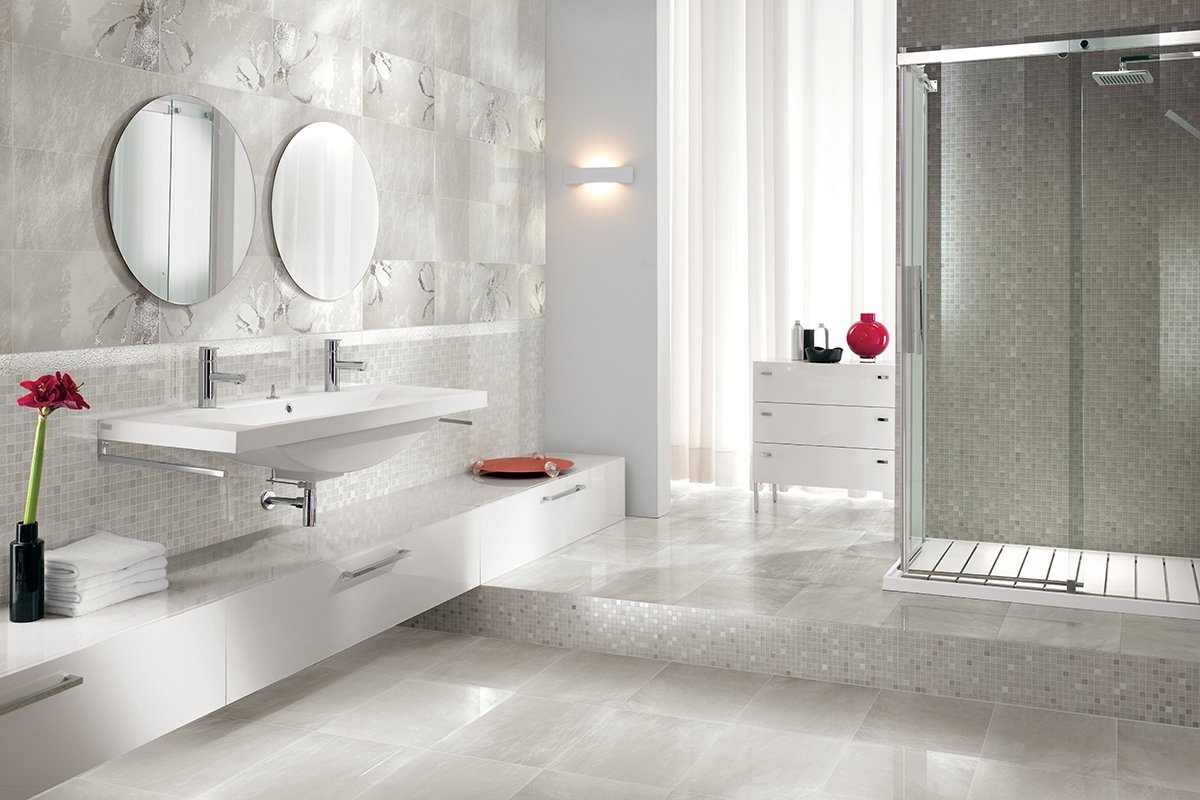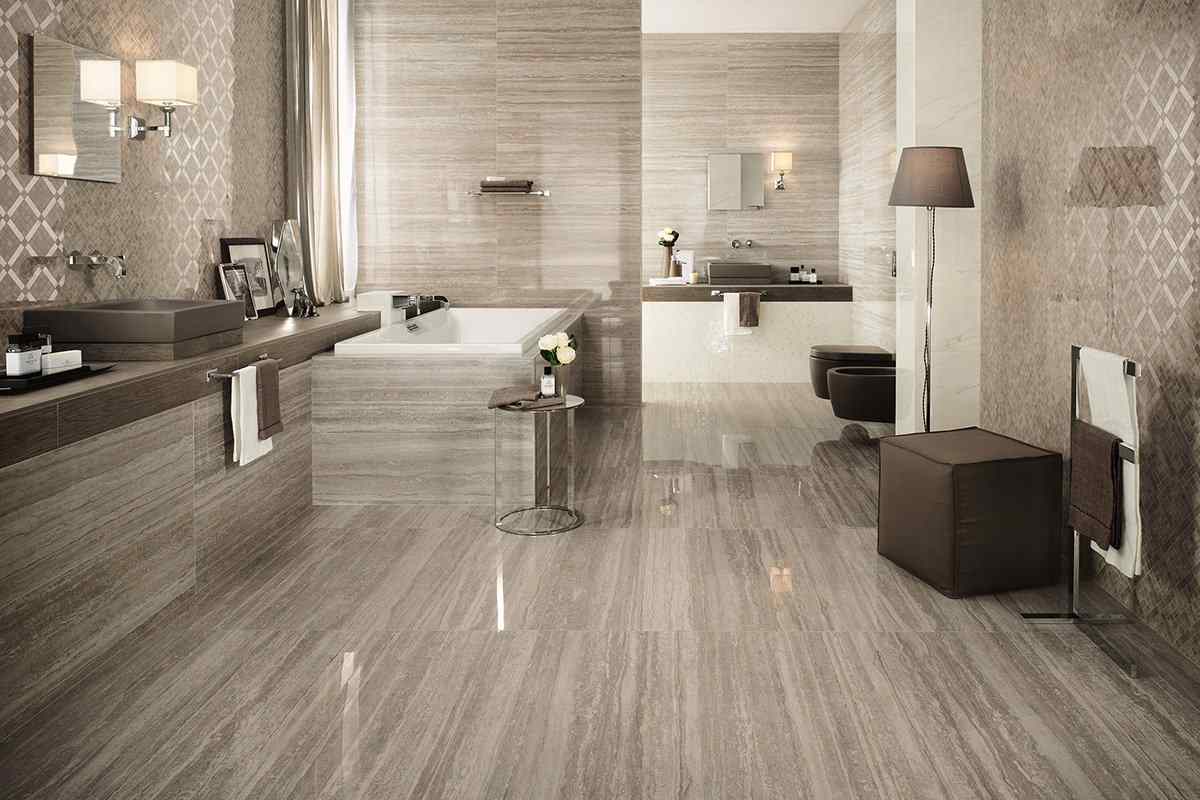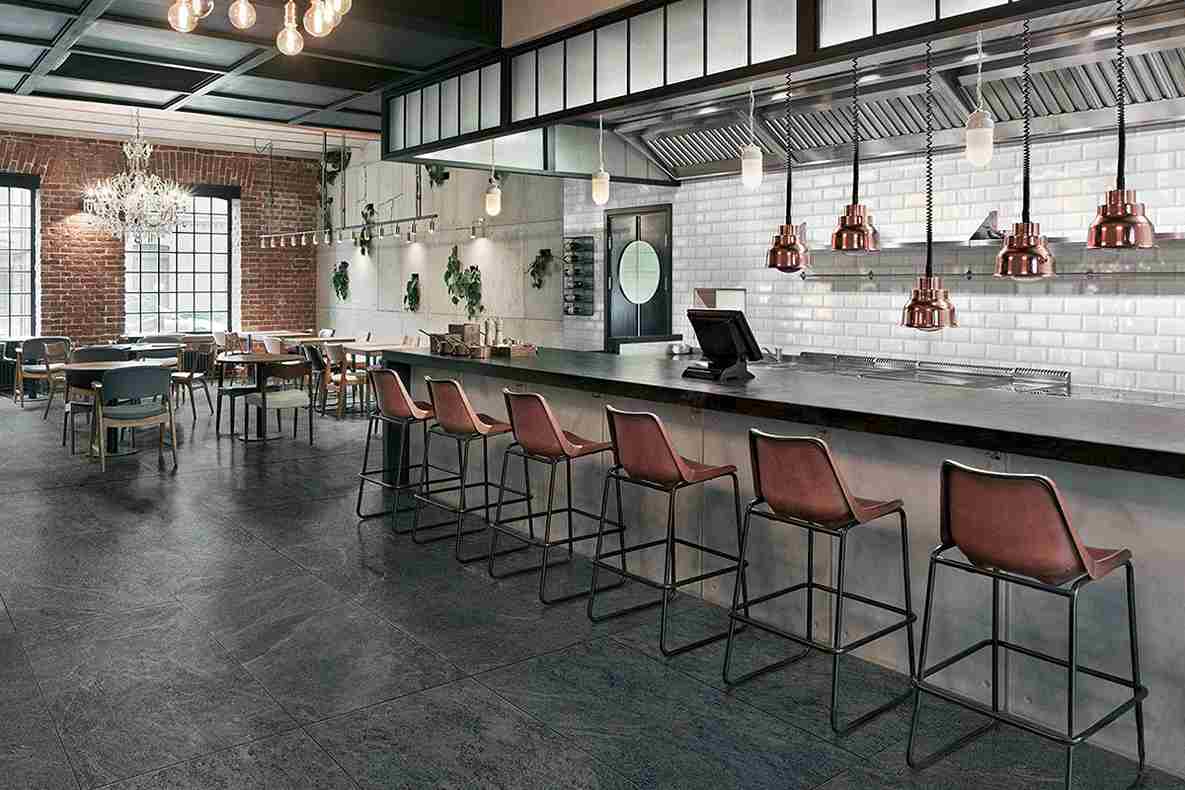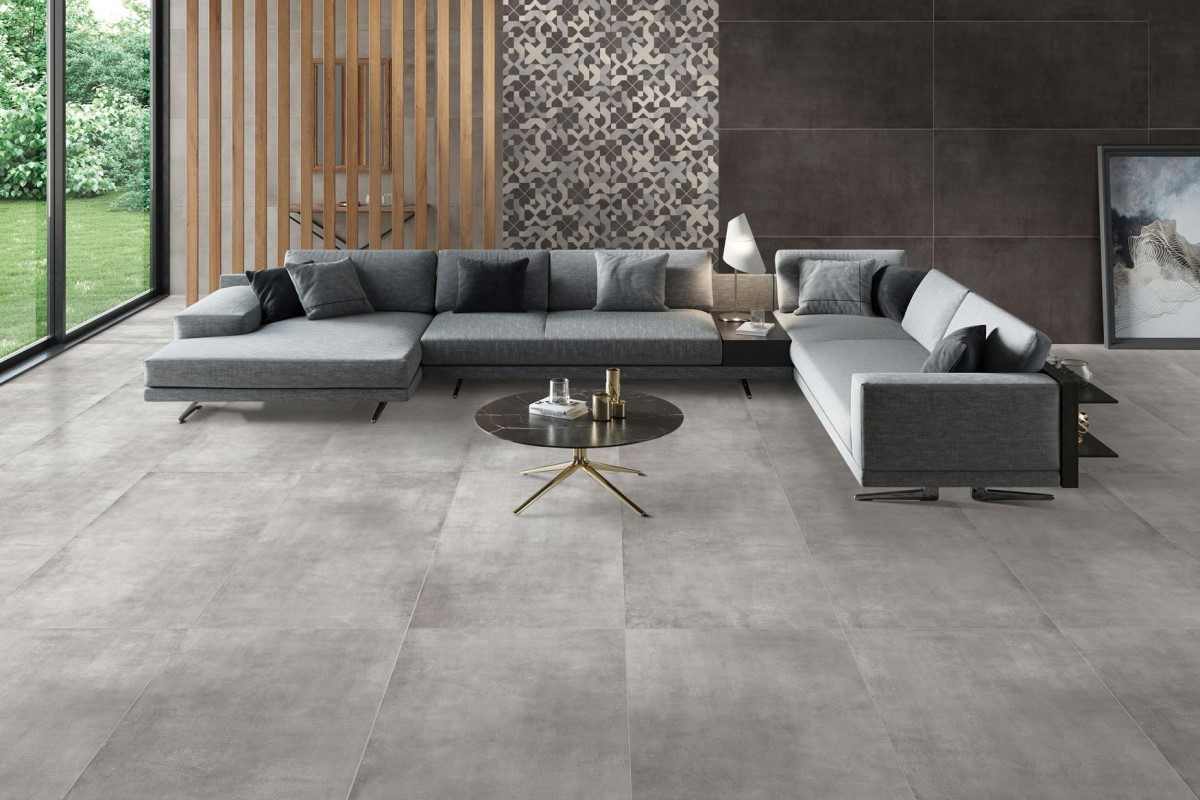The number of different "types" of ceramic tile used today appears almost equal to or between the number of "styles" of tile. We had gone a long way since the 1970s, when the majority of bathroom wall tiles were Johnsons "chicken" tiles that were 6" square and available in a dozen various colors, with Japanese floor tiles that were made of glazed mosaics. We now have vitrified porcelain, both full-bodied and double-loaded, as well as a plethora of glazed porcelain tiles, available with a matte glaze, a gloss glaze, a "lappato" or semi-polished finish, plus a variety of textured, slip-resistant tiles, in addition to the bicottura and monocottura types that dominated the residential market until the late 1990s.  Similarly, totally vitrified, unglazed porcelain tiles are available in a range of finishes. Even if it's not always simple to tell what kind of tile anything is just by looking at it, understanding the differences is essential if you want to pick the best tile for the job at hand and stay safe. We have compiled a useful overview of the most popular tile kinds, their performance characteristics, where to use them, and how to maintain them to help you navigate this difficult terminology maze. In addition, we dispel several falsehoods and misinformation about glazed and unglazed tiles. Ceramic tile: Depending on the type of tile, ceramic tile is made of clay combined with sand, felspar, quartz, and water. The mixture is then compressed firmly and burned at temperatures between 1000 and 1300 degrees Celsius. Either the MONOCOTTURA or BICOTTURA method can be used to make ceramic tiles. Tiles made with the monocottura process, which is Italian for "single-fired," are typically used on floors. However, they can also be used on walls. When firing monocottura tiles, both the body and the glaze are burned quickly and simultaneously at a high temperature. The vast majority of all home floor tiles were produced using this technique up until the late 1990s. The bicottura process is used to create wall tiles, which offer a wider choice of colors and beautiful surfaces.
Similarly, totally vitrified, unglazed porcelain tiles are available in a range of finishes. Even if it's not always simple to tell what kind of tile anything is just by looking at it, understanding the differences is essential if you want to pick the best tile for the job at hand and stay safe. We have compiled a useful overview of the most popular tile kinds, their performance characteristics, where to use them, and how to maintain them to help you navigate this difficult terminology maze. In addition, we dispel several falsehoods and misinformation about glazed and unglazed tiles. Ceramic tile: Depending on the type of tile, ceramic tile is made of clay combined with sand, felspar, quartz, and water. The mixture is then compressed firmly and burned at temperatures between 1000 and 1300 degrees Celsius. Either the MONOCOTTURA or BICOTTURA method can be used to make ceramic tiles. Tiles made with the monocottura process, which is Italian for "single-fired," are typically used on floors. However, they can also be used on walls. When firing monocottura tiles, both the body and the glaze are burned quickly and simultaneously at a high temperature. The vast majority of all home floor tiles were produced using this technique up until the late 1990s. The bicottura process is used to create wall tiles, which offer a wider choice of colors and beautiful surfaces.  The number of glaze layers used may affect how many times these tiles are actually burned, contrary to what the translation suggests. Bicottura tiles are fired at a lower temperature than monocottura tiles since hardness is not a necessary outcome. In general, tougher tiles result from greater temperatures. Ceramic tiles absorb over 4% of water. They should not be viewed as having a flaw or a limitation because full vitrification is an unnecessary step in their production. Porcelain tile is technically a member of the ceramic family but has unique qualities because of the kinds and combinations of clays used in its creation as well as those processes. Ceramic is a much weaker counterpart of porcelain. Both are produced from clay and heated in a kiln. The primary distinction is that porcelain tiles are entirely vitrified, which makes them extremely hard and suited for heavy traffic floors, including industrial settings, with a water absorption rate of less than 0.5%. Porcelain tiles can be utilized in almost any scenario, including factory floors, swimming pools, and light traffic bathroom floors (and walls) as well as in and around them (as mosaics). The tremendous pressure used to press the clay—up to 100,000 lbs per square inch—the volcanic temperature—approximately 1250 degrees Celsius—and the combination of clays and minerals employed—are the three key contributors to this porosity rate. The variation in the clay mix, which includes kaolin, felspar, quartziferous sand, and metallic oxides, drives all the other variables since it allows for intense pressing and burning. (White china clay, known as kaolin, is essential for helping the tile hold its shape during the fire.)
The number of glaze layers used may affect how many times these tiles are actually burned, contrary to what the translation suggests. Bicottura tiles are fired at a lower temperature than monocottura tiles since hardness is not a necessary outcome. In general, tougher tiles result from greater temperatures. Ceramic tiles absorb over 4% of water. They should not be viewed as having a flaw or a limitation because full vitrification is an unnecessary step in their production. Porcelain tile is technically a member of the ceramic family but has unique qualities because of the kinds and combinations of clays used in its creation as well as those processes. Ceramic is a much weaker counterpart of porcelain. Both are produced from clay and heated in a kiln. The primary distinction is that porcelain tiles are entirely vitrified, which makes them extremely hard and suited for heavy traffic floors, including industrial settings, with a water absorption rate of less than 0.5%. Porcelain tiles can be utilized in almost any scenario, including factory floors, swimming pools, and light traffic bathroom floors (and walls) as well as in and around them (as mosaics). The tremendous pressure used to press the clay—up to 100,000 lbs per square inch—the volcanic temperature—approximately 1250 degrees Celsius—and the combination of clays and minerals employed—are the three key contributors to this porosity rate. The variation in the clay mix, which includes kaolin, felspar, quartziferous sand, and metallic oxides, drives all the other variables since it allows for intense pressing and burning. (White china clay, known as kaolin, is essential for helping the tile hold its shape during the fire.)  The clay dust particles are squeezed very closely together, and the amount of air and moisture between the particles is decreased by injecting the pigmented dry dust clay into molds and pressing at such amazing pressure. A denser, less porous body results from this. Because of the characteristics of porcelain clay, dust particles melt and fuse together to form vitrification when fired at a temperature of about 1250 degrees Celsius. The process of vitrification. It is the process of turning melted clay into a " glass-like " material with a porosity of only 0.5%. The harder the tile and the less porous, the less likely it is to absorb liquids and become stained. Additionally, the less likely it is to scratch or chip, the greater the vitrification. Of course, the less likely moisture is to penetrate a tile's surface, the more likely it is to sit on the surface, which may raise the risk of slipping depending on the texture of the surface. Vitrified tiles come in four varieties: full body, double loaded, glazed, and soluble salt. This last type won't be taken into account in this article for a number of reasons.
The clay dust particles are squeezed very closely together, and the amount of air and moisture between the particles is decreased by injecting the pigmented dry dust clay into molds and pressing at such amazing pressure. A denser, less porous body results from this. Because of the characteristics of porcelain clay, dust particles melt and fuse together to form vitrification when fired at a temperature of about 1250 degrees Celsius. The process of vitrification. It is the process of turning melted clay into a " glass-like " material with a porosity of only 0.5%. The harder the tile and the less porous, the less likely it is to absorb liquids and become stained. Additionally, the less likely it is to scratch or chip, the greater the vitrification. Of course, the less likely moisture is to penetrate a tile's surface, the more likely it is to sit on the surface, which may raise the risk of slipping depending on the texture of the surface. Vitrified tiles come in four varieties: full body, double loaded, glazed, and soluble salt. This last type won't be taken into account in this article for a number of reasons. 
Unglazed Porcelain Tile
Unglazed Porcelain: Full-bodied porcelain is a sort of vitrified tile in which a single color extends continuously from the tile's surface to its base. The technical characteristics, such as water absorption, frost resistance, and acid resistance, are also constant throughout, in addition to the color. Before burning, two layers of clay—typically of different colors—are compressed together to create double-loaded tiles. The two layers fuse to create a perfectly uniform product because the clay is entirely made of porcelain. When the top layer's color is created using very expensive pigments, such as cobalt, this is typically done. It keeps the costs in check by limiting the color to the top 3–4mm rather than the entire 9–10mm. Traditional encaustic tiles have recessed areas created when the decorative pattern is stamped into the top surface of the base tile. These recessed areas are then filled with contrasting colored "slip" (liquid clay), which is then fired to create a homogeneous porcelain tile with the same characteristics as a full-bodied porcelain product. Polished porcelain that is not coated with a gloss finish is shiny but unglazed. It is an unglazed tile that has been mechanically polished in the same way that polished marble or granite tiles are polished to make them shiny. Polished porcelain requires sealing in the same way that polished marble or granite tiles do to keep them from becoming stained. Polishing porcelain changes the material's technical properties, particularly how much it absorbs.  Standard, or "matte," porcelain does not collect dirt and stains because of its finely textured surface, although it might show soiling that is limited to the tile's surface and is easily washable. The use of a penetrating sealer is required because mechanical polishing by the factory results in a smoother surface that is much less prone to catch and hold dirt from shoes, etc., but damages the tiny porcelain dust beads and opens up the tile's microscopic pores. The porcelain tile becomes slick when wet as a result of polishing, which smooths the surface to a bright, mirror sheen. (Despite the fact that they are more slippery—and hence dangerous—when wet—polished porcelain tiles are typically used for public thoroughfares in shopping malls because they are easier and less expensive to maintain.) The polished, or lappato, unglazed porcelain tiles must be cleaned with a specially developed pH-neutral cleanser after a penetrating sealer has been put to their surface. Standard floor cleaners have a high pH level that degrades the sealer, diminishing its effectiveness and limiting its life. It is advised to use polished porcelain on walls or floors where there is little to no danger of their getting wet because applying a quality penetrating sealer will only address the staining problem and not the slipperiness issue. Although matte-finished tiles are slip-resistant, it is always advisable to check the manufacturer's slip rating. Varied colors may produce a different slip rating even with matte-finished, unglazed porcelain. A lappato, or honed, finish on unglazed porcelain will have a slip rating that falls midway between polished and matte. Only utilize textured surfaces outside due to their difficulty in cleaning and extremely high non-slip rating. Porcelain that has been "glazed": Most people think the word "glazed" means "shiny" or "glossy." However, the term is used to describe the colored or patterned coating that is applied to a tile's surface in the tile industry.
Standard, or "matte," porcelain does not collect dirt and stains because of its finely textured surface, although it might show soiling that is limited to the tile's surface and is easily washable. The use of a penetrating sealer is required because mechanical polishing by the factory results in a smoother surface that is much less prone to catch and hold dirt from shoes, etc., but damages the tiny porcelain dust beads and opens up the tile's microscopic pores. The porcelain tile becomes slick when wet as a result of polishing, which smooths the surface to a bright, mirror sheen. (Despite the fact that they are more slippery—and hence dangerous—when wet—polished porcelain tiles are typically used for public thoroughfares in shopping malls because they are easier and less expensive to maintain.) The polished, or lappato, unglazed porcelain tiles must be cleaned with a specially developed pH-neutral cleanser after a penetrating sealer has been put to their surface. Standard floor cleaners have a high pH level that degrades the sealer, diminishing its effectiveness and limiting its life. It is advised to use polished porcelain on walls or floors where there is little to no danger of their getting wet because applying a quality penetrating sealer will only address the staining problem and not the slipperiness issue. Although matte-finished tiles are slip-resistant, it is always advisable to check the manufacturer's slip rating. Varied colors may produce a different slip rating even with matte-finished, unglazed porcelain. A lappato, or honed, finish on unglazed porcelain will have a slip rating that falls midway between polished and matte. Only utilize textured surfaces outside due to their difficulty in cleaning and extremely high non-slip rating. Porcelain that has been "glazed": Most people think the word "glazed" means "shiny" or "glossy." However, the term is used to describe the colored or patterned coating that is applied to a tile's surface in the tile industry.  For example, one can have marble with a "glossy" surface or unglazed porcelain that is "glossy," but neither product is "glazed." The glaze is a material, not a description of a textural finish. Like how you can have matte paint for your walls and gloss paint for your doors and skirting, think of glaze as paint. The paint for your tiles is glaze. The majority of floor tiles and almost all wall tiles are glazed. Before the tile enters the kiln, the glaze is applied; during the firing process, it fuses to the porcelain body's surface. Glazed porcelain tiles have the same four basic glaze finishes as unglazed porcelain tiles: gloss, matte, lappato, and textured, of which there are several variations. Lappato-glazed tiles shine more than matte tiles but have a softer touch than gloss tiles. The term "honed"—a term used frequently in the stone business to describe marble with a satin finish rather than a highly polished, shining one—comes from the Italian meaning "semi-polished" or "honed." Inkjet Printing: Thanks to recent developments in glazing technology, porcelain tiles may now be printed with any digital image you can think of. With up to 1000 nozzles and a resolution of up to 1000 dpi, inkjet printers can use up to six different colors. The most noteworthy quality of this printing method is its incredible versatility, which includes the ability to print all the way to the edge of the tile and reproduce natural stone, wood, terrazzo, concrete, or any other pictorial image with excellent accuracy and without the use of screens, which created a pixelated effect.
For example, one can have marble with a "glossy" surface or unglazed porcelain that is "glossy," but neither product is "glazed." The glaze is a material, not a description of a textural finish. Like how you can have matte paint for your walls and gloss paint for your doors and skirting, think of glaze as paint. The paint for your tiles is glaze. The majority of floor tiles and almost all wall tiles are glazed. Before the tile enters the kiln, the glaze is applied; during the firing process, it fuses to the porcelain body's surface. Glazed porcelain tiles have the same four basic glaze finishes as unglazed porcelain tiles: gloss, matte, lappato, and textured, of which there are several variations. Lappato-glazed tiles shine more than matte tiles but have a softer touch than gloss tiles. The term "honed"—a term used frequently in the stone business to describe marble with a satin finish rather than a highly polished, shining one—comes from the Italian meaning "semi-polished" or "honed." Inkjet Printing: Thanks to recent developments in glazing technology, porcelain tiles may now be printed with any digital image you can think of. With up to 1000 nozzles and a resolution of up to 1000 dpi, inkjet printers can use up to six different colors. The most noteworthy quality of this printing method is its incredible versatility, which includes the ability to print all the way to the edge of the tile and reproduce natural stone, wood, terrazzo, concrete, or any other pictorial image with excellent accuracy and without the use of screens, which created a pixelated effect.  This explains why glazed porcelain tiles are frequently used in bathrooms for both the walls and the floors, with gloss or lappato glazed tiles being more popular for the walls. The ability to print on non-flat surfaces, including curved or textured ones, is another distinctive quality of this technique. This broadens the range of image types that can be generated and the applications for the tiles. Only with an inkjet printer is it possible to decorate over frit grains since there is no physical contact with the surface. Frit: Frit is a type of ceramic glass that has been pre-mixed from raw, finely ground minerals, melted, and then finely pulverized. The type and grade of frit will influence the glaze's endurance as well as its level of hardness, color, and gloss. Porcelain tiles with glaze do not need to be sealed because it is the glaze's intended use. Consider them to be like your ceramic tableware; while your plates don't require sealing to prevent stains, they do require washing. Damage to the glaze is one of the characteristics of glazed porcelain that is frequently recognized as an issue or a potential problem. What are the effects of a damaged glazed surface on a tile, both practically and aesthetically? The answer to this query has less to do with glazed porcelain tiles specifically and more to do with the type of glazed porcelain tile being used and where. If the tile is of great quality, it is quite unlikely that something will fall on it and scratch or chip the glaze. Keep in mind that these tiles were created to be installed on the floor and walked on. Should damage to the surface occur, some glazed porcelain tiles feature a porcelain body that is colored to match or nearly resemble the color of the glaze. It is suggested to avoid using such a tile in a high usage location because there will be visible wear if there is a large difference between the glaze and body colors.
This explains why glazed porcelain tiles are frequently used in bathrooms for both the walls and the floors, with gloss or lappato glazed tiles being more popular for the walls. The ability to print on non-flat surfaces, including curved or textured ones, is another distinctive quality of this technique. This broadens the range of image types that can be generated and the applications for the tiles. Only with an inkjet printer is it possible to decorate over frit grains since there is no physical contact with the surface. Frit: Frit is a type of ceramic glass that has been pre-mixed from raw, finely ground minerals, melted, and then finely pulverized. The type and grade of frit will influence the glaze's endurance as well as its level of hardness, color, and gloss. Porcelain tiles with glaze do not need to be sealed because it is the glaze's intended use. Consider them to be like your ceramic tableware; while your plates don't require sealing to prevent stains, they do require washing. Damage to the glaze is one of the characteristics of glazed porcelain that is frequently recognized as an issue or a potential problem. What are the effects of a damaged glazed surface on a tile, both practically and aesthetically? The answer to this query has less to do with glazed porcelain tiles specifically and more to do with the type of glazed porcelain tile being used and where. If the tile is of great quality, it is quite unlikely that something will fall on it and scratch or chip the glaze. Keep in mind that these tiles were created to be installed on the floor and walked on. Should damage to the surface occur, some glazed porcelain tiles feature a porcelain body that is colored to match or nearly resemble the color of the glaze. It is suggested to avoid using such a tile in a high usage location because there will be visible wear if there is a large difference between the glaze and body colors.
